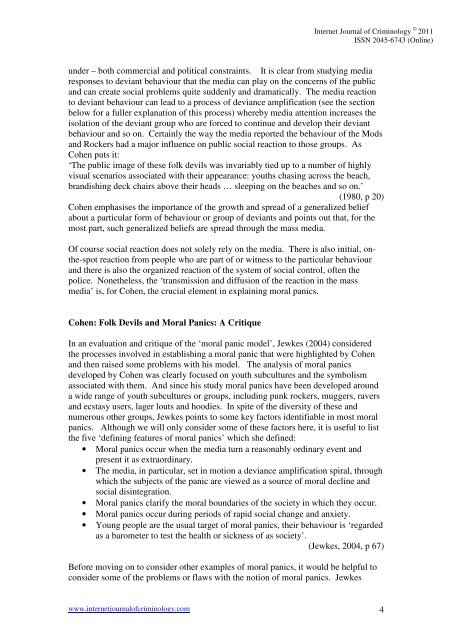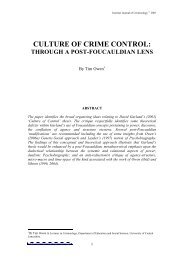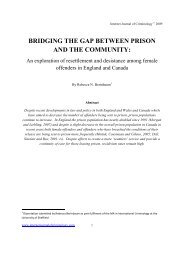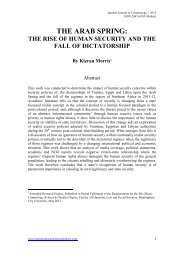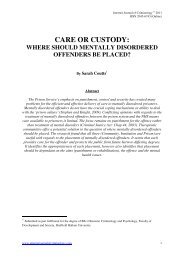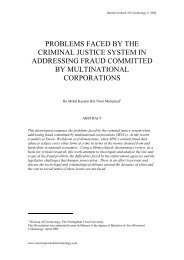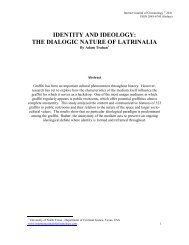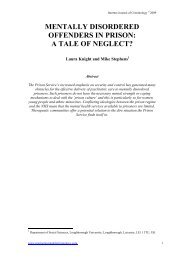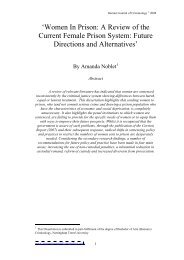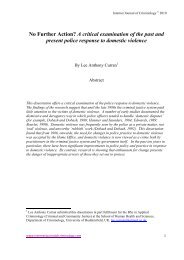moral panics and the british media - Internet Journal of Criminology
moral panics and the british media - Internet Journal of Criminology
moral panics and the british media - Internet Journal of Criminology
Create successful ePaper yourself
Turn your PDF publications into a flip-book with our unique Google optimized e-Paper software.
<strong>Internet</strong> <strong>Journal</strong> <strong>of</strong> <strong>Criminology</strong> © 2011<br />
ISSN 2045-6743 (Online)<br />
under – both commercial <strong>and</strong> political constraints. It is clear from studying <strong>media</strong><br />
responses to deviant behaviour that <strong>the</strong> <strong>media</strong> can play on <strong>the</strong> concerns <strong>of</strong> <strong>the</strong> public<br />
<strong>and</strong> can create social problems quite suddenly <strong>and</strong> dramatically. The <strong>media</strong> reaction<br />
to deviant behaviour can lead to a process <strong>of</strong> deviance amplification (see <strong>the</strong> section<br />
below for a fuller explanation <strong>of</strong> this process) whereby <strong>media</strong> attention increases <strong>the</strong><br />
isolation <strong>of</strong> <strong>the</strong> deviant group who are forced to continue <strong>and</strong> develop <strong>the</strong>ir deviant<br />
behaviour <strong>and</strong> so on. Certainly <strong>the</strong> way <strong>the</strong> <strong>media</strong> reported <strong>the</strong> behaviour <strong>of</strong> <strong>the</strong> Mods<br />
<strong>and</strong> Rockers had a major influence on public social reaction to those groups. As<br />
Cohen puts it:<br />
‘The public image <strong>of</strong> <strong>the</strong>se folk devils was invariably tied up to a number <strong>of</strong> highly<br />
visual scenarios associated with <strong>the</strong>ir appearance: youths chasing across <strong>the</strong> beach,<br />
br<strong>and</strong>ishing deck chairs above <strong>the</strong>ir heads … sleeping on <strong>the</strong> beaches <strong>and</strong> so on.’<br />
(1980, p 20)<br />
Cohen emphasises <strong>the</strong> importance <strong>of</strong> <strong>the</strong> growth <strong>and</strong> spread <strong>of</strong> a generalized belief<br />
about a particular form <strong>of</strong> behaviour or group <strong>of</strong> deviants <strong>and</strong> points out that, for <strong>the</strong><br />
most part, such generalized beliefs are spread through <strong>the</strong> mass <strong>media</strong>.<br />
Of course social reaction does not solely rely on <strong>the</strong> <strong>media</strong>. There is also initial, on<strong>the</strong>-spot<br />
reaction from people who are part <strong>of</strong> or witness to <strong>the</strong> particular behaviour<br />
<strong>and</strong> <strong>the</strong>re is also <strong>the</strong> organized reaction <strong>of</strong> <strong>the</strong> system <strong>of</strong> social control, <strong>of</strong>ten <strong>the</strong><br />
police. None<strong>the</strong>less, <strong>the</strong> ‘transmission <strong>and</strong> diffusion <strong>of</strong> <strong>the</strong> reaction in <strong>the</strong> mass<br />
<strong>media</strong>’ is, for Cohen, <strong>the</strong> crucial element in explaining <strong>moral</strong> <strong>panics</strong>.<br />
Cohen: Folk Devils <strong>and</strong> Moral Panics: A Critique<br />
In an evaluation <strong>and</strong> critique <strong>of</strong> <strong>the</strong> ‘<strong>moral</strong> panic model’, Jewkes (2004) considered<br />
<strong>the</strong> processes involved in establishing a <strong>moral</strong> panic that were highlighted by Cohen<br />
<strong>and</strong> <strong>the</strong>n raised some problems with his model. The analysis <strong>of</strong> <strong>moral</strong> <strong>panics</strong><br />
developed by Cohen was clearly focused on youth subcultures <strong>and</strong> <strong>the</strong> symbolism<br />
associated with <strong>the</strong>m. And since his study <strong>moral</strong> <strong>panics</strong> have been developed around<br />
a wide range <strong>of</strong> youth subcultures or groups, including punk rockers, muggers, ravers<br />
<strong>and</strong> ecstasy users, lager louts <strong>and</strong> hoodies. In spite <strong>of</strong> <strong>the</strong> diversity <strong>of</strong> <strong>the</strong>se <strong>and</strong><br />
numerous o<strong>the</strong>r groups, Jewkes points to some key factors identifiable in most <strong>moral</strong><br />
<strong>panics</strong>. Although we will only consider some <strong>of</strong> <strong>the</strong>se factors here, it is useful to list<br />
<strong>the</strong> five ‘defining features <strong>of</strong> <strong>moral</strong> <strong>panics</strong>’ which she defined:<br />
• Moral <strong>panics</strong> occur when <strong>the</strong> <strong>media</strong> turn a reasonably ordinary event <strong>and</strong><br />
present it as extraordinary.<br />
• The <strong>media</strong>, in particular, set in motion a deviance amplification spiral, through<br />
which <strong>the</strong> subjects <strong>of</strong> <strong>the</strong> panic are viewed as a source <strong>of</strong> <strong>moral</strong> decline <strong>and</strong><br />
social disintegration.<br />
• Moral <strong>panics</strong> clarify <strong>the</strong> <strong>moral</strong> boundaries <strong>of</strong> <strong>the</strong> society in which <strong>the</strong>y occur.<br />
• Moral <strong>panics</strong> occur during periods <strong>of</strong> rapid social change <strong>and</strong> anxiety.<br />
• Young people are <strong>the</strong> usual target <strong>of</strong> <strong>moral</strong> <strong>panics</strong>, <strong>the</strong>ir behaviour is ‘regarded<br />
as a barometer to test <strong>the</strong> health or sickness <strong>of</strong> as society’.<br />
(Jewkes, 2004, p 67)<br />
Before moving on to consider o<strong>the</strong>r examples <strong>of</strong> <strong>moral</strong> <strong>panics</strong>, it would be helpful to<br />
consider some <strong>of</strong> <strong>the</strong> problems or flaws with <strong>the</strong> notion <strong>of</strong> <strong>moral</strong> <strong>panics</strong>. Jewkes<br />
www.internetjournal<strong>of</strong>criminology.com 4


